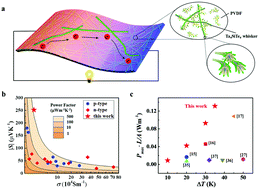当前位置:
X-MOL 学术
›
Energy Environ. Sci.
›
论文详情
Our official English website, www.x-mol.net, welcomes your feedback! (Note: you will need to create a separate account there.)
Conformal organic–inorganic semiconductor composites for flexible thermoelectrics
Energy & Environmental Science ( IF 32.5 ) Pub Date : 2020/01/10 , DOI: 10.1039/c9ee03776d Qing Xu 1, 2, 3, 4, 5 , Sanyin Qu 1, 2, 3, 4, 5 , Chen Ming 1, 2, 3, 4, 5 , Pengfei Qiu 1, 2, 3, 4, 5 , Qin Yao 1, 2, 3, 4, 5 , Chenxi Zhu 1, 2, 3, 4, 5 , Tian-Ran Wei 5, 6, 7, 8, 9 , Jian He 10, 11, 12, 13 , Xun Shi 1, 2, 3, 4, 5 , Lidong Chen 1, 2, 3, 4, 5
Energy & Environmental Science ( IF 32.5 ) Pub Date : 2020/01/10 , DOI: 10.1039/c9ee03776d Qing Xu 1, 2, 3, 4, 5 , Sanyin Qu 1, 2, 3, 4, 5 , Chen Ming 1, 2, 3, 4, 5 , Pengfei Qiu 1, 2, 3, 4, 5 , Qin Yao 1, 2, 3, 4, 5 , Chenxi Zhu 1, 2, 3, 4, 5 , Tian-Ran Wei 5, 6, 7, 8, 9 , Jian He 10, 11, 12, 13 , Xun Shi 1, 2, 3, 4, 5 , Lidong Chen 1, 2, 3, 4, 5
Affiliation

|
The development of flexible organic–inorganic thermoelectric composites constitutes a promising material approach toward harvesting heat from the human body or environment to power wearable electronics. To this end, compositing one-dimensional inorganic materials, such as carbon nanotubes or metal nanowires, with organic polymers has demonstrated efficacy but also drawbacks: e.g., the Seebeck coefficient of an inorganic constituent is too low to meet the onset voltage requirement of electronics, and it is hard to attain coherent interfaces between the inorganic and organic constituents. Here, we proposed a dimensionality/morphology matching strategy and conducted a proof-of-principle study on (PVDF)/Ta4SiTe4 organic–inorganic composites. A record high normalized maximum power density of 0.13 W m−1 at a temperature difference of 35.5 K was obtained in prototype flexible thermoelectric modules made of (PVDF)/Ta4SiTe4 composites. This study attests to the efficacy of the dimensionality/morphology matching strategy and the potential of using such conformal semiconducting organic–inorganic composites in wearable electronics.
中文翻译:

柔性热电材料的共形有机-无机半导体复合材料
柔性有机-无机热电复合材料的开发构成了一种有前途的材料方法,可以从人体或环境中收集热量,为可穿戴电子设备供电。为此,将一维无机材料(例如碳纳米管或金属纳米线)与有机聚合物复合已证明具有功效,但也存在缺点:例如,无机成分的塞贝克系数太低,无法满足电子设备的起始电压要求;而且很难在无机和有机成分之间实现连贯的界面。在这里,我们提出了尺寸/形态匹配策略,并对(PVDF)/ Ta 4 SiTe 4进行了原理验证研究。有机-无机复合材料。在由(PVDF)/ Ta 4 SiTe 4复合材料制成的原型柔性热电模块中,在35.5 K的温差下获得了创纪录的高归一化最大功率密度,为0.13 W m -1。这项研究证明了尺寸/形态匹配策略的有效性,以及在可穿戴电子产品中使用此类保形半导体有机-无机复合材料的潜力。
更新日期:2020-02-19
中文翻译:

柔性热电材料的共形有机-无机半导体复合材料
柔性有机-无机热电复合材料的开发构成了一种有前途的材料方法,可以从人体或环境中收集热量,为可穿戴电子设备供电。为此,将一维无机材料(例如碳纳米管或金属纳米线)与有机聚合物复合已证明具有功效,但也存在缺点:例如,无机成分的塞贝克系数太低,无法满足电子设备的起始电压要求;而且很难在无机和有机成分之间实现连贯的界面。在这里,我们提出了尺寸/形态匹配策略,并对(PVDF)/ Ta 4 SiTe 4进行了原理验证研究。有机-无机复合材料。在由(PVDF)/ Ta 4 SiTe 4复合材料制成的原型柔性热电模块中,在35.5 K的温差下获得了创纪录的高归一化最大功率密度,为0.13 W m -1。这项研究证明了尺寸/形态匹配策略的有效性,以及在可穿戴电子产品中使用此类保形半导体有机-无机复合材料的潜力。


























 京公网安备 11010802027423号
京公网安备 11010802027423号